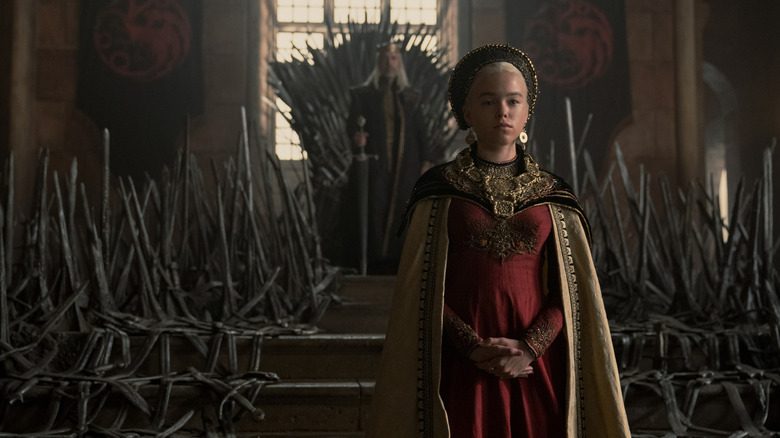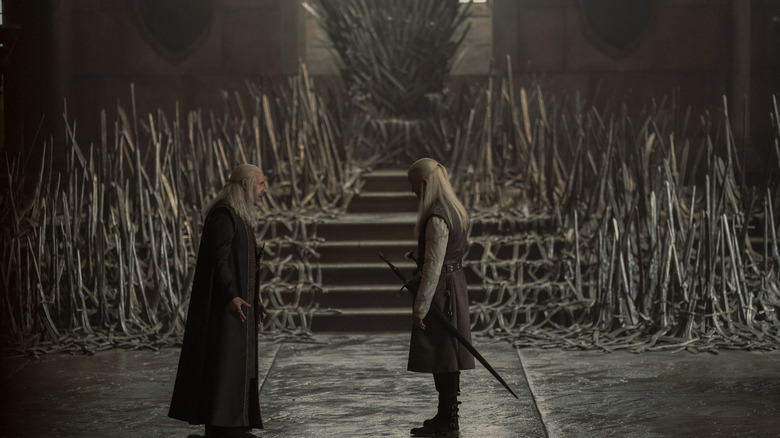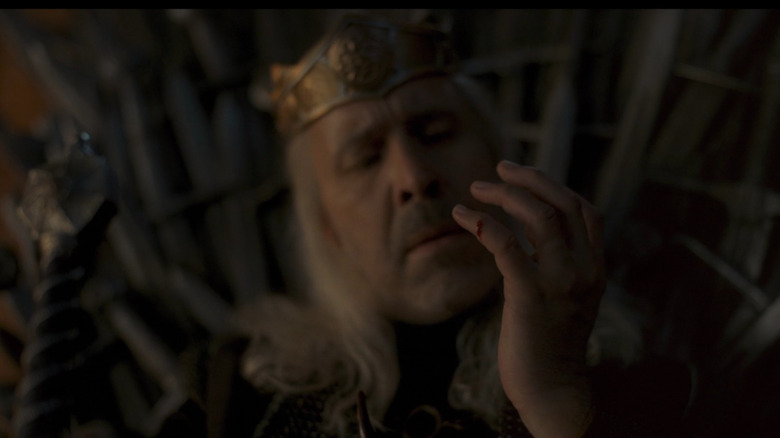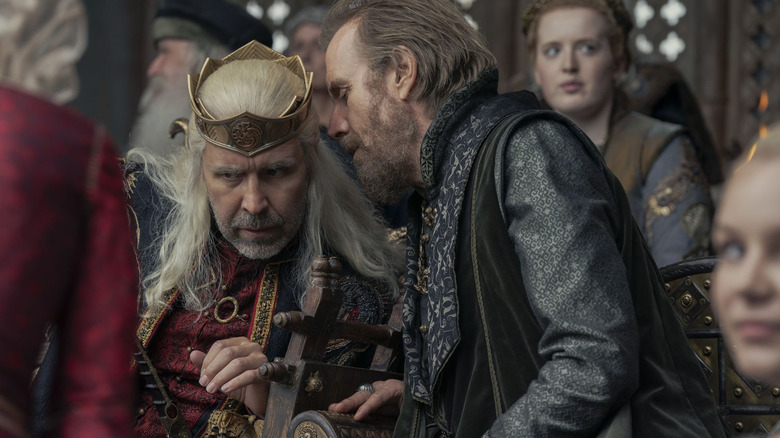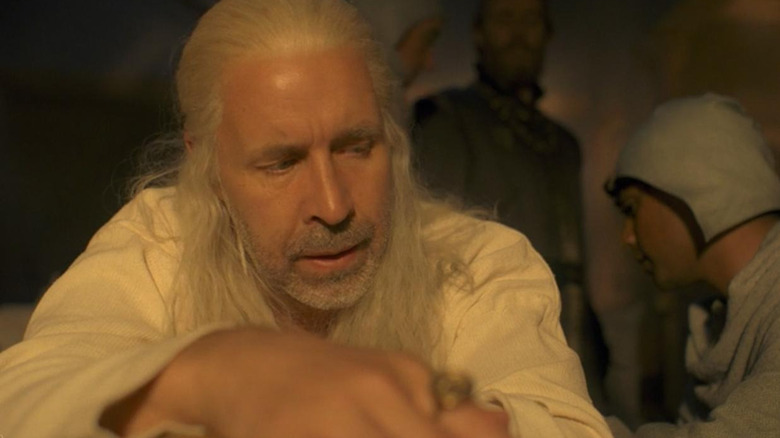Why The Iron Throne Itself Is The Biggest Threat In House Of The Dragon
This post contains spoilers for season 1 episode two of "House of the Dragon."
If you don't have an affinity for giant fire-breathing reptiles, then the Westeros of "House of the Dragon" is a terrifying place. But for the silver-haired powerhouses with Valyrian blood in their veins, the seven kingdoms are theirs to rule and no one would dare defy them, lest they end up cooked by dragon fire. Otto Hightower (Rhys Ifans) almost learns this the hard way when he comes face-to-face with Daemon Targaryen's (Matt Smith) large dragon Caraxes. In the end, the only way to talk the rogue Prince down is with another dragon-rider — his niece Rhaenyra (Milly Alcock), who flies in and refuses to back down. This certainly won't stop schemers like Otto Hightower and Corlys Velaryon (Steve Toussaint) from trying to seize power, but how can they stand a chance against the dragon-riding Targaryens? How can anyone? It seems pretty unlikely that the next couple of seasons of this series will see the Targaryens going unquestioned in their rule, but who would dare to stand in their way?
Well, here's the thing — we've already seen a Targaryen defeated. Daenerys came in hot, with a massive army and three dragons, but eventually, her numbers dwindled, her flames fizzled and her reign ended before it even began. Though we're 200 years in the past, the very same obstacle that kept Daenerys from achieving her goals now threatens the success of the Targaryen dynasty: the Iron Throne itself.
Everyone's striving for the seat of power
There are a couple of different layers to this idea. In Daenerys' case, her pursuit of the Iron Throne blinded her to the world and the morals that once guided her ambitions. Even though she never actually sat on the throne, her drive for power became a corrupting force. But here's a big difference: when we catch up with her ancestors in the prequel series, the Targaryen dynasty is at the peak of its power. The throne is unquestionably theirs — they built it decades ago with fire and blood. This time, the conflict is coming from inside the house.
Daemon and Rhaenyra both have their eyes set on the seat of power and after the events of episode two, there's a good chance King Viserys (Paddy Considine) will be popping out additional babies to challenge them both. Then there's the matter of social strivers like Corlys and Otto, who both tried to turn their daughters into queens by pimping them out to old Viserys. Only Otto succeeded, and the king found himself a new wife of his choosing. But the cost of turning Corlys down has sent him running to Daemon, and with the second sons forming an alliance, what will that mean for Viserys' reign?
So yeah, in a metaphorical sense, everyone's shared desire for the throne makes it a major threat to the Targaryen rule. But beyond that, there's the very physical damage that the throne has inflicted on King Viserys. To our knowledge, the Targaryen ruler has sustained two different injuries from his time sitting on the throne and neither of his cuts seem to be healing very well. So metaphors be damned, the Iron Throne is quite literally killing this dynasty.
The Iron Throne bites back
Alright, fine, maybe I'm blowing this out of proportion. Maybe it's not that serious! Maybe this is nothing more than a sign to the Targaryens that they should do the logical thing and relegate the Iron Throne to a museum. Replace it with a Lay-Z-Boy, for God's sake. Get a regal-looking lawn chair in there! Even the world's dumbest-looking chair has to be an upgrade from the most uncomfortable seat in Westeros.
Or maybe this is very serious indeed. Maybe this is a bad omen about the future of their dynasty.
All that stuff I said about the Iron Throne being ridiculously dangerous and uncomfortable — maybe that's a feature, rather than a bug. According to Westerosi lore, the Iron Throne was built by Aegon the Conqueror with the swords of his vanquished enemies. The creatives behind "House of the Dragon" took very special care to construct a throne that better represents the one George R.R. Martin described in his books; rather than the vaguely sword-themed chair of "Game of Thrones," this version is a massive mix of jagged edges and blades. It's not a seat that can ever be comfortable and Martin has always maintained that Aegon did this on purpose.
This throne was built to root out the unworthy: those who don't mind themselves on the seat of power and aren't vigilant of surrounding threats will be easily cut. Spilling blood on the throne then becomes a symbol of their weakness. And this isn't just an idea floated by Martin — it's something acknowledged by the people of Westeros. Daenerys's father, the Mad King Aerys II, was so well-known for cutting himself on the Iron Throne blades that he earned the nickname 'King Scab.' In the end, he was betrayed and usurped by his people.
The weakness of King Viserys
So far, Viserys has earned two cuts (that we know of): one before the series began and a second when he banished Daemon from court. If you believe that the Iron Throne can truly pass judgment, does this mean that banishing Daemon was a mistake? Viserys had a pretty good reason for his anger — his brother needs to be put in check. But Daemon also understood what Viserys refuses to see: his own weakness. Though we've only known him for two episodes, Viserys has proven himself weak at almost every turn. If he can help it, he avoids conflict completely. But that's not a strategy, it's just deflection.
When Daemon holes up at Dragonstone, Viserys chooses to ignore the problem. While the Crabfeeder pillages nearby islands, he opts to ignore the problem. Even when the issue is the very simple matter of having a conversation with his daughter, Viserys dodges confrontation. And as Corlys later tells him, this just shows the realm how vulnerable House Targaryen has become. Viserys, who is most content with model cities and his teenage girlfriend, doesn't seem cut out to sit on the Iron Throne and it won't take very long for everyone else to figure that out too.
Why aren't the cuts healing?
Metaphors and omens aside, the most pressing issue is the simple fact that Viserys' cuts aren't getting any better. Is there an explanation for his rotting finger and puss-filled wound? The show has yet to provide one, but in the meantime, we can certainly speculate.
If we're being logical, then we can probably assume it has to do with the failures of medieval medical practices. When Grand Maester Mellos — the man responsible for the King's health — is examining Viserys' back wound, he seems utterly stumped. Ultimately, he opts to cauterize it. When episode two rolls around, his solution for the rotting pinky finger is a big ol' bowl of maggots. Westerosi hospitals are just not the place to be. Honestly, we shouldn't be too surprised: in "Game of Thrones," Samwell Tarly, a s***-cleaning trainee, accidentally cured Greyscale because he had the revolutionary idea to peel off the infected area. That just seems like the kind of thing you try first, no? But evidently, the Maesters are dangerously incurious when it comes to progress. No wonder they still rely on maggots. On the other hand, maybe Viserys' wounds are doomed regardless of medical expertise. Did anyone think to clean the swords before crafting the world's worst chair? Who knows what kind of infections they're riddled with! His pinky never stood a chance.
To get a bit conspiratorial, is it wise that the only people aware of Viserys' injury are Otto Hightower and Maester Mellos? While he trusts both of them without question, is his judgment sound? Isn't it a dangerous advantage for anyone to know the king's weaknesses? This just connects back to the most dangerous issue at the center of everything: whether he realizes it or not, through his inaction and terrible observation skills, King Viserys is weakening House Targaryen.
